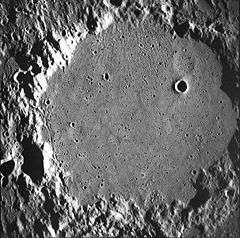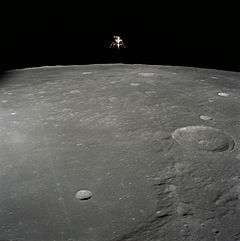Ptolemaeus (lunar crater)
|
| |
| Coordinates | 9°12′S 1°48′W / 9.2°S 1.8°WCoordinates: 9°12′S 1°48′W / 9.2°S 1.8°W |
|---|---|
| Diameter | 153 km |
| Depth | 2.4 km |
| Colongitude | 3° at sunrise |
| Eponym | Claudius Ptolemaeus |
Ptolemaeus is an ancient lunar impact crater close to the center of the near side, named for Claudius Ptolemy, the Greco-Roman writer, mathematician, astronomer, geographer and astrologer.
To the south-southeast, Ptolemaeus is joined to the rim of the crater Alphonsus by a section of rugged, irregular terrain, and these form a prominent chain with Arzachel to the south. To the southeast is Albategnius and to the north is the smaller but well-defined Herschel.
The features of Ptolemaeus are highlighted when the Sun is at low angles during the first and last quarter. At full Moon the Sun is directly overhead and the crater contours become more difficult to discern.
The crater has a low, irregular outer rim that is heavily worn and impacted with multiple smaller craters. The rim has a discernibly polygonal shape, although overall it remains circular. The largest of the peaks along the rim, designated Ptolemaeus Gamma (γ), has an altitude of 2.9 km and is located along the northwest rim. The crater has no central peak, a lava-flooded floor, and lacks a ray system. Impact sites of this form are often classified as walled plains, due to their resemblance to the maria.
The somewhat dark-hued floor of Ptolemaeus is notable for several ghost craters, formed where lava has covered a pre-existing crater. These leave only a slight rise where the rim existed, and are difficult to detect except at low angles of sunlight. There are also multiple smaller craters across the floor surface, most notably Ammonius in the northeastern quadrant.
On either side of this crater are linear, irregular gashes in the lunar surface, forming valley-like features. These features are approximately parallel to each other and radiate from the direction of Mare Imbrium to the north-northwest.
Satellite craters
By convention these features are identified on lunar maps by placing the letter on the side of the crater midpoint that is closest to Ptolemaeus.
| Ptolemaeus | Latitude | Longitude | Diameter |
|---|---|---|---|
| B | 7.9° S | 0.7° W | 17 km |
| C | 10.1° S | 3.3° W | 3 km |
| D | 8.2° S | 2.5° W | 4 km |
| E | 10.2° S | 4.5° W | 32 km |
| G | 7.1° S | 0.1° E | 7 km |
| H | 7.1° S | 5.4° W | 7 km |
| J | 9.6° S | 5.4° W | 5 km |
| K | 8.2° S | 4.6° W | 8 km |
| L | 8.8° S | 4.0° W | 4 km |
| M | 9.4° S | 3.4° W | 3 km |
| O | 7.2° S | 3.6° W | 5 km |
| P | 11.4° S | 3.2° W | 4 km |
| R | 6.7° S | 1.2° W | 6 km |
| S | 10.5° S | 0.5° W | 4 km |
| T | 7.5° S | 0.0° E | 7 km |
| W | 9.1° S | 1.4° E | 4 km |
| X | 10.9° S | 0.3° E | 4 km |
| Y | 9.3° S | 0.7° E | 6 km |
The following crater has been renamed by the IAU.
- Ptolemaeus A — See Ammonius.
References
| Wikimedia Commons has media related to Ptolemaeus (crater). |
- Wood, Chuck (2005-04-06). "Micro-Topo". Lunar Photo of the Day. Retrieved 2006-07-21.
- Andersson, L. E.; Whitaker, E. A. (1982). NASA Catalogue of Lunar Nomenclature. NASA RP-1097.
- Blue, Jennifer (October 18, 2010). "Gazetteer of Planetary Nomenclature". USGS. Retrieved 2014-10-16.
- Bussey, B.; Spudis, P. (2004). The Clementine Atlas of the Moon. New York: Cambridge University Press. ISBN 978-0-521-81528-4.
- Cocks, Elijah E.; Cocks, Josiah C. (1995). Who's Who on the Moon: A Biographical Dictionary of Lunar Nomenclature. Tudor Publishers. ISBN 978-0-936389-27-1.
- McDowell, Jonathan (July 15, 2007). "Lunar Nomenclature". Jonathan's Space Report. Retrieved 2007-10-24.
- Menzel, D. H.; Minnaert, M.; Levin, B.; Dollfus, A.; Bell, B. (1971). "Report on Lunar Nomenclature by the Working Group of Commission 17 of the IAU". Space Science Reviews. 12 (2): 136–186. Bibcode:1971SSRv...12..136M. doi:10.1007/BF00171763.
- Moore, Patrick (2001). On the Moon. Sterling Publishing Co. ISBN 978-0-304-35469-6.
- Price, Fred W. (1988). The Moon Observer's Handbook. Cambridge University Press. ISBN 978-0-521-33500-3.
- Rükl, Antonín (1990). Atlas of the Moon. Kalmbach Books. ISBN 978-0-913135-17-4.
- Webb, Rev. T. W. (1962). Celestial Objects for Common Telescopes (6th revised ed.). Dover. ISBN 978-0-486-20917-3.
- Whitaker, Ewen A. (1999). Mapping and Naming the Moon. Cambridge University Press. ISBN 978-0-521-62248-6.
- Wlasuk, Peter T. (2000). Observing the Moon. Springer. ISBN 978-1-85233-193-1.

